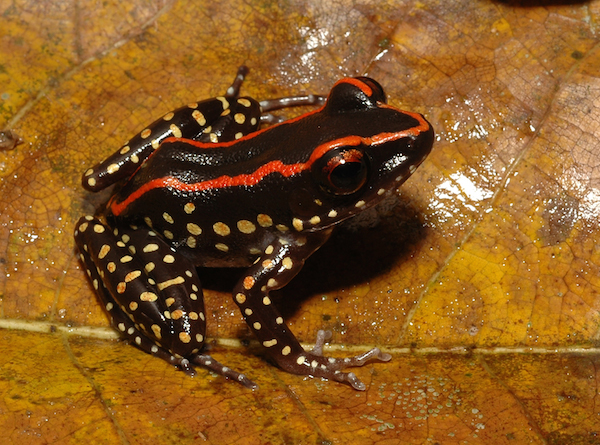Scientists have identified a new species of frog on the Malay Peninsula. The newly named Hylorana centropeninsularis was discovered in a peat swamp and genetic analyses revealed that it is evolutionarily distinct from its stream-dwelling cousins.
After publishing the discovery in the online journal Herpetologica, Kin Onn Chan, a doctoral candidate at the University of Kansas, told mongabay.com that the frog was actually first found 10 years ago.
“An ex-student of my ex-advisor at the National University of Malaysia collected it in one of her pit-fall traps… After digging through historical records and literature, we found that it was not the first time that that particular 'species' had been found,” Chan said.
Yet this original breakthrough went unrecognized when the frog was misidentified due to striking similarities with another species (Hylarana siberu) living in Sumatra, which is also black with orange stripes and yellow spots. But when Chan’s team examined their own Malaysian specimen, they became suspicious about the distance between the two habitats.
“Despite these similarities, it actually strengthened our suspicion that it was a new species because based on the Unified Species Concept, we know that it was quite improbable for the Peninsular Malaysian populations to be sharing genes with populations from Sumatra,” he said.
Tissue samples were sent back to a lab at the University of Kansas for genetic analysis and the team’s suspicions were confirmed. They had indeed identified a new species, although they speculate that both frogs probably share a common ancestor because the Strait of Malacca, the stretch of ocean that separates the two species, was once a land bridge.
The researchers named their rediscovery centropeninsularis, referring to the frog’s home, the center of Peninsular Malaysia. According to Chan, this was part of an effort to raise awareness of the region’s natural significance.
“I wanted to bring attention to Peninsular Malaysia,” he said. “When it comes to biodiversity and conservation, a lot of attention has been given to Borneo, Indonesia and Indochina but Peninsular Malaysia has always been overlooked.”

A peat swamp in Malaysian Borneo. Photo by Rhett A. Butler.
Hylorana centropeninsularis has evolved to live in peat swamp, a tropical forest habitat characterized by waterlogged soil, which is home unique groups of animals. Chan and his team have spent years studying the biodiversity of peat swamps and suspect they may house many more new species awaiting scientific observation.
“Swamp/peat ecosystems are very unique and species that live there have adapted to a very specialized lifestyle,” Chan said. “Due to the insular nature of many swap/peat habitats, it would be hard for species to disperse away… hence limiting gene flow.”
But peat forests are experiencing a rapid decline. In the last two decades alone, the proportion of forested peat swamp in Peninsular Malaysia, Sumatra, and Borneo dropped 41 percent. Of the peat forests that remain, less than 10 percent are legally protected.
According to the Malaysian Nature Society, the forests containing Malaysia’s peat swamps are under threat from loggers as well as fires started by local famers which have already degraded thousands of hectors of woodland. In 2013, the Malaysian Department of Environment imposed a ban on “open burning” in certain areas of the country to tackle the problem.
Citations:
Kin Onn Chan, Rafe M. Brown, Kelvin K.P. Lim, Norhayati Ahmad and Lee Grismer. 2014. A New Species Of Frog (Amphiba: Anura: Ranidae) of the Hylarana Signata Complex from Peninsular Malaysia. Herpetologica, 70(2), 2014, 228–240

The new frog species, Hylorana centropeninsularis. Photo by Chan et al. |